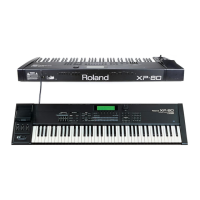Extracting and moving a part of sequencer
data – 10 Extract
This function extracts a specified sequencer data area from a
Phrase track or Pattern and moves it to the same Song posi-
tion of another Phrase track or Pattern.
It also allows you to reorganize the sequencer data for MIDI
channels so each channel's data is placed in its own Phrase
track– handy when the sequencer data for multiple MIDI
channels has been stored together in one Phrase track (such
as with Format 0 Standard MIDI files).
Source track
Selects a Phrase track or Pattern from which data is to be
extracted.
TRK 1–TRK 16: The specified Phrase track
PTN 001–PTN 100: The specified Pattern
Measure (From), for (to) (Editing area)
Specifies the area of measures from which data is to be
extracted.
Destination track
Selects a Phrase track or Pattern into which the data will be
inserted.
TRK ALL: The sequencer data of MIDI channel 1 will be
moved to Phrase track 1 and MIDI channel 16’s data moves
to Phrase track 16.
TRK 1–TRK 16: The specified Phrase track
PTN 001–PTN 100: The specified Pattern
Mode (Extract mode)
Specifies whether you want to keep the sequencer data at the
destination.
REPLACE: The data at the destination will be erased and
replaced by the extracted data. However, only the data of
the MIDI channels specified by the Channel parameter will
be replaced, and data of other channels at the destination
will remain.
MIX: The data at the destination will combine with the
extracted data.
Status
Selects the type of data to be extracted.
ALL: All types of sequencer data
NOTE: Note
P.AFT: Polyphonic Aftertouch
C.C: Controller numbers
PROG: Program numbers
C.AFT: Channel Aftertouch
BEND: Pitch Bend
EXC: System Exclusive messages
TUNE: Tune Request
PTN: Pattern Call messages
Range
If you have selected NOTE, P.AFT, C.C or PROG for the
Status parameter, use this parameter to specify the area.
To extract all Note or Polyphonic Aftertouch data, specify
“C-1–G9.” To extract C4 Note/Polyphonic Aftertouch data,
specify “C4–C4.” To extract Note/Polyphonic Aftertouch
data over the range from C3 to C4, specify “C3–C4.”
To extract all Controller numbers or Program numbers, spec-
ify “0–127.” To extract Controller/Program number 4, speci-
fy “4–4.” To extract Controller/Program numbers from 3 to
14, specify “3–14.”
Channel (MIDI channel)
Selects the MIDI channel(s) of the data to be extracted.
To extract all sequencer data, set this parameter to ALL. To
extract just the sequencer data of a specific MIDI channel,
select that MIDI channel.
✳ If you set the Status parameter to EXC, TUNE or PTN,
the Channel parameter will not be available.
<Procedure>
❶ Make sure that the Track Edit Menu display (SEQ/
TrkEdit) is up.
❷ Press [F6] (Menu) to select Menu 2, then press [F5]
(Extract) to call up the Extract display (SEQ/TrkEdit).
This display can also be called up by moving the cursor to
“10 Extract” and pressing [ENTER] on the Track Edit Menu
display (SEQ/TrkEdit). Or press the numeric keys [1] and
[0], then [ENTER].
❸ Move the cursor to the Source track and select the Phrase
track or Pattern from which you want to extract data.
❹ When assigning the editing area by measures, move
the cursor to “Measure” and specify the measure num-
ber at which extraction is to start, then move the cursor
to “for” to specify the measure length for extraction.
When using Locate positions, press [LOCATE], and move the
cursor to “From” to select the Locate number from where you
want to start extracting. Then move the cursor to “to” and
select the Locate number where you want to end extraction.
❺ Move the cursor to the Destination track and select the
Phrase track(s) or Pattern into which the extracted data
will be inserted.
❻ Move the cursor to “Mode” to specify extraction
method.
❼ Move the cursor to “Status” to select the data for
extraction.
If you select NOTE, P.AFT, C.C or PROG, move the cursor to
“Range” and specify the area. For NOTE or P.AFT, you can
specify the key range by pressing keys of the keyboard.
❽ Move the cursor to “Channel” and select the MIDI
channel from which you want to extract data.
❾ Press [F6] (Execute) to initiate extracting.
✳ Source and Destination parameters cannot be set to the
same setting. If you execute the operation with the
same setting, the display will show “Same Track or
Pattern Selected.” Select different Phrase tracks or
Patterns and execute the operation again.

